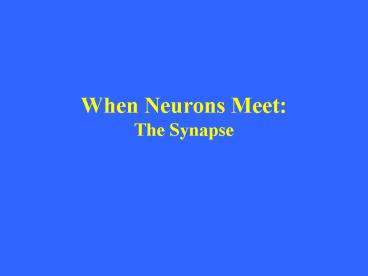When Neurons Meet: The Synapse - PowerPoint PPT Presentation
1 / 23
Title:
When Neurons Meet: The Synapse
Description:
The term 'synapse' was first introduced by Charles Sherrington ... up and move into active zone in revolver-like fashion ... 23. Illustration of the ... – PowerPoint PPT presentation
Number of Views:104
Avg rating:3.0/5.0
Title: When Neurons Meet: The Synapse
1
When Neurons Meet The Synapse
2
Synapse
- The term synapse was first introduced by
Charles Sherrington to describe the zone of
contact between neurons
3
Synapse Characteristics
- Synaptic Cleft 20-40 nm distance
- Presynaptic Active Zones Presynaptic Vesicles
- Postsynaptic receptors
- NT flow (always Unidirectional)
- Transmission delay of .3 to 5 msec
4
Exemplar - Multipolar Synapse
- From thousands of pre synaptic terminals
- From inhibitory and excitatory cells
5
Membrane
- Stimulation
- From thousands of pre synaptic terminals
- From inhibitory and excitatory cells
- By NT binding result in inhibitory and excitatory
membrane response (graded potentials) - Membrane excitatory postsynaptic potentials
(EPSPs) - Membrane inhibitory postsynaptic potentials
(IPSPs)
6
Anatomy of the Synapse
7
Pre Synaptic Membrane
- The terminal button at the synapse
- Synaptic vesicles loaded with NT sit
- Where action potentials cause synaptic vesicles
to fuse with presynaptic membrane and release
massive NT - The greater the stimulation the greater NT
release - Terminal buttons occasionally release small
amounts of NT even w/out cell stimulation
8
Synaptic Vesicles
- Synaptic Vesicles
- Formed in Cell nucleus
- Transported via microfilament tracks to terminal
button - At synaptic terminal vesicles are filled with
several thousand molecules of NT
9
Pre-synaptic Membrane Active Zones
- Vesicles line up and move into active zone in
revolver-like fashion - Note Fusion of synaptic vesicles and
presynaptic membrane
10
Synaptic Cleft
- Region separating pre/post synaptic cell
(Cytoplasmic discontinuity) - Width 20-40 nm distance
- NT are released into synaptic cleft
11
Post-Synaptic Membrane
- Contain NT docking sites called receptors
- - NT released into synaptic cleft bind to
specific postsynaptic sites - - NT do not produce EPSP or IPSP
- - NT binding produce inhibitory and excitatory
response (graded potentials) - NT do not produce EPSP or IPSP
12
Post Synaptic Membrane
- Stimulation
- From thousands of pre synaptic terminals
- From inhibitory and excitatory cells
- By NT binding result in inhibitory and excitatory
membrane response (graded potentials) - Membrane excitatory postsynaptic potentials
(EPSPs) - Membrane inhibitory postsynaptic potentials
(IPSPs)
13
NT Binding
- NT bind to specialized - receptors
- NT-receptor Binding opens specific ion channels
- Opening of specific ion channels initiate EPSP
and IPSP
14
NT Receptor Binding
- Two Types of Post synaptic Receptors
- Ionotropic receptors NT binding results in
direct opening of specific ion channels - Metabotropic receptors binding of NT initiates
a sequence of internal molecular events which in
turn open specific ion channels
15
NT binding -gt Membrane Potential Response
16
Mechanism of Neurotransmission
17
Anatomy of the Synapse
18
Types of Synapses
- Axo-dendritic synapse
- Axo-axo synapse
- Axo-soma synapse
19
What happens after NT release?
- Presynaptic
- Synaptic vesicles are recycled
- Repackaged
- In Synaptic Cleft
- Transmission termination
- Postsynaptic
- Membrane excitatory postsynaptic potentials
(EPSPs) - Membrane inhibitory postsynaptic potentials
(IPSPs)
20
At the Synaptic Cleft
- NT Termination
- Three methods
- Diffusion
- Reuptake
- Enzymatic degradation
- E.g., AchE hydrolizes Ach into acetyl and choline
21
And,
- Neurotransmitters flow from one neuron to another
neuron across the synapse continue the neural
message
22
When a Neuron Meets a Muscle The Neuromuscular
Junction
- Site where motor neuron meets the muscle fiber
- Separated by gap called the neuromuscular cleft
- Motor end plate
- A pocket of the muscle that surrounds the
neurons den - Acetylcholine is released from the motor neuron
- Causes an end-plate potential (EPP)
- Depolarization of muscle fiber
23
Illustration of the Neuromuscular Junction































